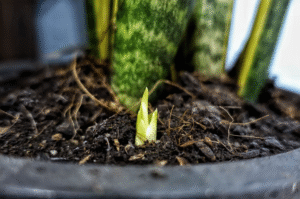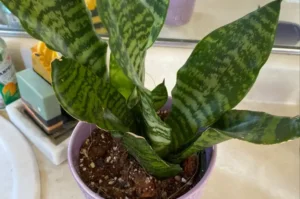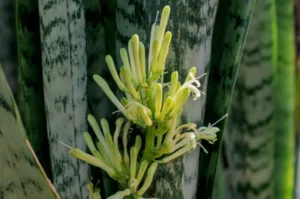The snake plant (Sansevieria), also known as mother-in-law’s tongue, is one of the easiest houseplants to grow and propagate. If you love this plant and want more of it without buying new ones, learning how to grow snake plant from cutting is the perfect solution.
This step-by-step guide will teach you how to propagate your snake plant successfully using leaf cuttings in both water and soil. Let’s dive in!
Why Choose Propagation by Cuttings?
Propagating a snake plant through cuttings is one of the easiest ways to multiply your plant. It’s especially helpful if your plant is damaged or if you’re pruning and don’t want to waste healthy leaves.
Here are some reasons why cuttings are a great method:
- Cost-effective: One plant can give you several new ones.
- Fun and educational: A perfect activity for plant lovers and beginners.
- Low risk: Cuttings require little care and attention.
- Eco-friendly: Great way to reuse trimmed or broken leaves.
This propagation method works well if you follow the right steps and use the correct materials.
When to Grow Snake Plant from Cuttings
Timing is important when it comes to successful propagation. The best time to grow a snake plant from a cutting is during the growing season usually spring to early summer. Warmer weather and longer daylight hours help the plant develop roots faster.
Avoid propagating during winter as the plant’s growth naturally slows down in colder months, and cuttings may take much longer to root or might rot.
Choosing and Cutting the Right Leaf
Selecting the right leaf is the foundation of healthy propagation. Here’s how to choose:
- Pick a mature, healthy leaf from the bottom of the plant.
- The leaf should be green, thick, and firm with no brown spots or signs of rot.
- Use a sharp, sterilized knife or scissors to cut the leaf near its base.
Once cut, you can divide the leaf into smaller pieces, each 3 to 5 inches long. Make sure to remember which end was the bottom (this is the end that goes into water or soil).
How to Propagate Snake Plant in Soil
This is the most common and reliable method for propagation. Here’s a detailed step-by-step guide:
Step 1: Allow the Cuttings to Callus
Place the leaf sections on a clean surface and let them sit for 1–2 days. This allows the cut edge to dry and callus, which helps prevent rot when planted in soil.
Step 2: Prepare the Pot
Use a small pot with drainage holes and fill it with well-draining soil, such as a cactus or succulent mix. You can also add some perlite for better aeration.
Step 3: Plant the Cuttings
Insert the callused end of each cutting into the soil about 1–2 inches deep. Make sure it’s placed upright with the correct end down.
Step 4: Water Sparingly
Water lightly just to moisten the soil. Snake plants are sensitive to overwatering, so let the soil dry completely between waterings.
Step 5: Place in Bright, Indirect Light
Keep the pot in a location with indirect sunlight. Avoid direct sun, which can damage the leaf.
Roots will begin forming in 3–6 weeks, and you’ll notice new growth within 2–3 months.
How to Grow Snake Plant in Water
If you prefer to see the rooting process, water propagation is a fun option. Here’s how to do it:
- Place the cut end of the leaf in a glass of clean water.
- Only the bottom 1–2 inches should be submerged.
- Use a clear container so you can watch root growth.
- Place it near a window with indirect sunlight.
- Change the water every 4–5 days to keep it fresh.
In 3–5 weeks, you’ll notice roots growing. Once roots are 1–2 inches long, you can plant the cutting in soil.
Tips for Faster and Healthier Rooting
To make sure your snake plant cutting grows successfully, keep these tips in mind:
- Use rooting hormone (optional) to boost root development.
- Don’t forget to label top and bottom ends of each cutting.
- Keep the area warm (70–85°F is ideal).
- Be patient – snake plants grow slowly but steadily.
- Use a spray bottle to lightly mist the soil instead of pouring water.
Common Problems and How to Avoid Them
Even though snake plants are easy to propagate, beginners sometimes make mistakes. Here’s how to avoid common issues:
- Rotting cuttings: Caused by overwatering or not letting cuttings callus first.
- No roots forming: Usually due to lack of light, poor soil, or incorrect temperature.
- Wrong orientation: Make sure to plant the cuttings with the original base end down.
How Long Does It Take for a Snake Plant to Root?
On average, cuttings take:
- 3 to 6 weeks to develop roots.
- 8 to 12 weeks to show new leaf growth.
This timeline depends on temperature, humidity, and light conditions. Warmer and brighter environments speed up the process.
Frequently Asked Questions (FAQs):
Can I grow a snake plant from a leaf that fell off?
Yes! As long as the leaf is still healthy and green, you can cut off the damaged part and use the rest for propagation.
Should I use fertilizer for the new cuttings?
It’s best to wait until new roots or leaves appear. After 2–3 months, you can use a diluted succulent fertilizer once a month.
How do I know if the cutting is successful?
Successful cuttings will develop firm roots and eventually push out new baby leaves. If the leaf turns mushy or brown, it may have rotted.
Conclusion
Now that you know how to grow snake plant from cutting, you can easily turn one plant into many! Whether you choose soil or water propagation, the process is simple and rewarding. With a little care and patience, you’ll have beautiful, healthy new snake plants that purify your air and brighten your home.
Start your propagation journey today, it’s a great way to grow your green space naturally!






